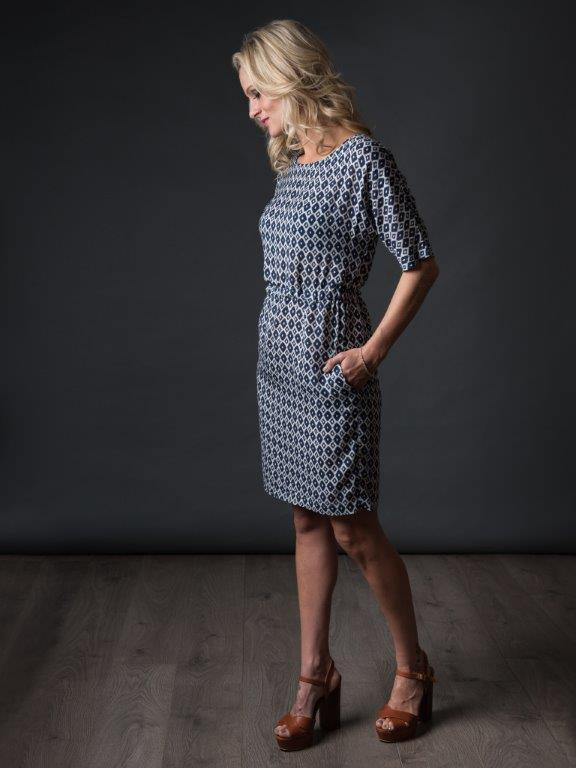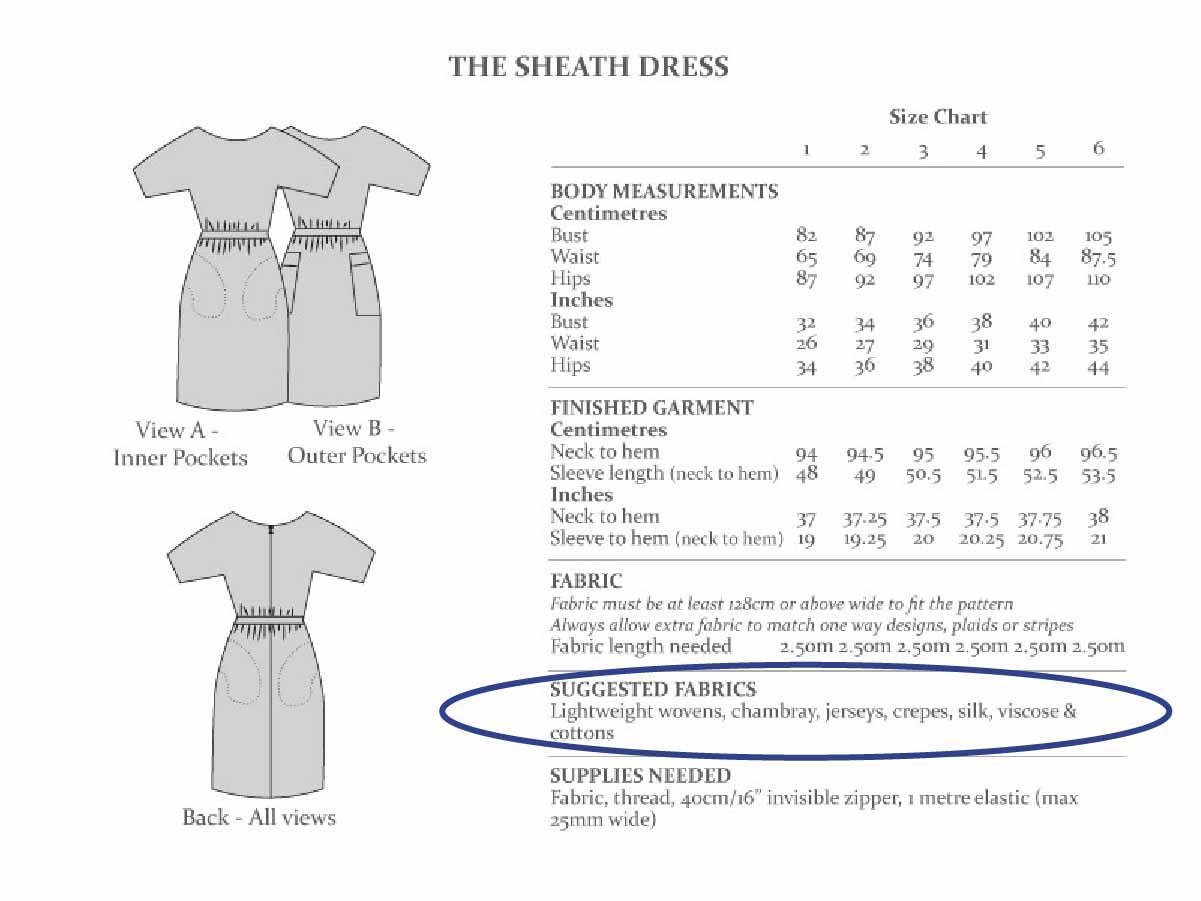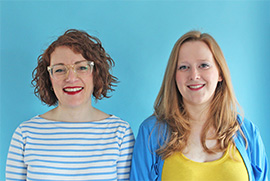The Sewing Pattern Tutorials: 1. fabric types

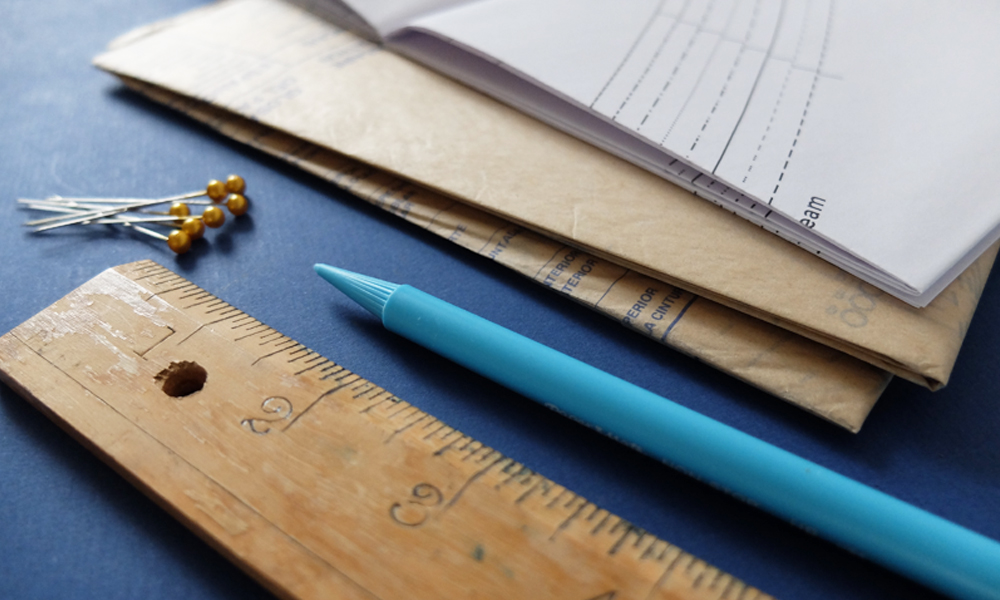

The pattern envelope: Fabric types
This is the first of a new year-long FREE sewing course where we will demystify dressmaking patterns. We’ll begin with the basics so that if you are new to sewing you can join in from the start. We also know that lots of you want to learn new sewing skills so as the year progresses we’ll begin to cover more complex topics so that you will finish with the skills needed to to deal with fitting problems too. In each post we will also have a sewing jargon busting section explaining any terms used that might be confusing. In the first few posts we will explain what all the information on the back of the pattern envelope means, starting with the most exciting part, choosing fabric!
Don’t forget your can search for sewing patterns by fabric type in our shop here. This is really useful if you already have fabric in your stash and you are not sure what you want to make with it.
Why do patterns have fabric suggestions and where do you find them?
Patterns often suggest fabrics you can use to make the garment you want to sew. This is really helpful if you are new to sewing because it gives you some reassurance that if you make the garment in that fabric, it will have the correct drape, fit and overall look of the picture on the front.
It is entirely up to the pattern designer how much information they give you on the pattern envelope so let’s take a look at two here.
The Avid Seamstress Sheath Dress
The Avid Seamstress lists Lightweight woven, chambray, jerseys, crepes, silk, viscose and cottons. See the fabric types below for a description of these fabric types and ‘sewing jargon explained’ for an explanation of what lightweight wovens are.
Vogue 1350 dress
Vogue Patterns list Silk Twill, Silk Dupioni and Crepe. Unsuitable for obvious diagonals. * With Nap. ** Without Nap.
Find out what obvious diagonals and nap mean below. Both Twill and Dupioni are types or silk and describe the way the fabrics are weaved and from what materials they are created. See the fabric types below for more examples.
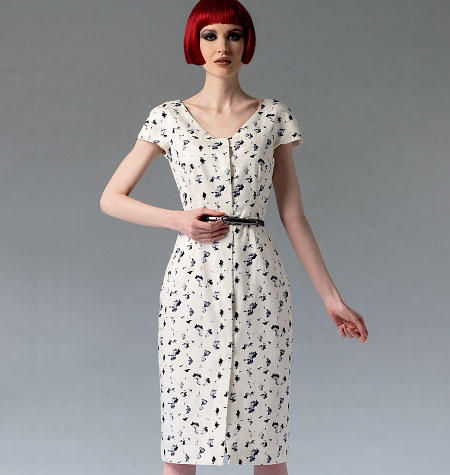
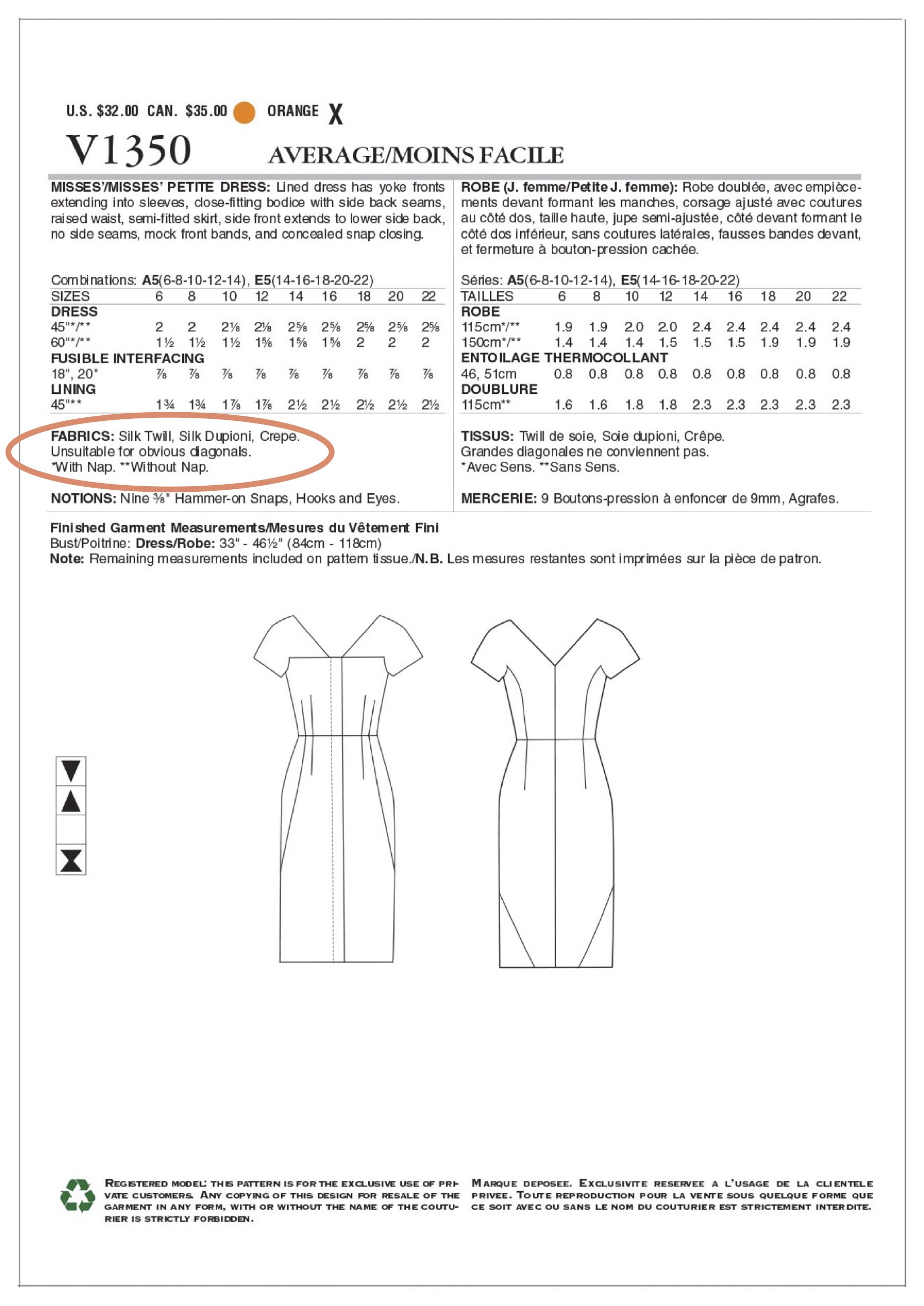
Can I use fabrics that aren’t recommended to make my garment?
It is possible to use fabrics not mentioned for the pattern but be careful, some fabrics are completely unsuitable for certain designs and the results will be unwearable. This is often true for patterns that require knit type fabrics (or not). As your sewing knowledge grows you will develop the skills to judge what fabrics will or won’t work for different pattern styles.
What should I do if my pattern doesn’t have any fabric recommendations?
There are a few questions you can ask yourself to help select a suitable fabric for your project:
a. What sort of garment do I want to make? For example if it’s a bikini you will need to find fabric with stretch, elasticity and suitable for use in water but if you want to make a blouse the options are much greater as lots of fabrics could be suitable, such as cotton, crepe, rayon or silk.
b. Should the fabric be light-weight or heavy-weight? And with or without drape? Should it have stretch or not? For example if you want to make a coat, you probably want to use a heavier-weight fabric with some drape such as a wool or if you are making a blouse, a lighter-weight fabric with plenty of drape such as silk. If it’s a tight fitting t-shirt then you will need fabric with some stretch.
Sewing jargon explained
What does fabric ‘drape’ mean and how does this relate to fabric ‘weight’?
How a fabric drapes is how it looks when it hangs, for dressmaking it is important how a fabric hangs on the body as this affects how the garment will look and the intended style. Drape does relate quite strongly to fabric weight but it is not always the case that heavier weight fabrics have less drape. It is true that stiff fabrics don’t have much drape but softer fabrics do. To test this hang the fabric over something, around your waist works well, and look at how the fabric falls and moves as you walk around. Remember that you can always make a drapey fabric more stiff if you interface it.
What does ‘with nap’ and ‘without nap’ mean?
Think velvet or corduroy, these are fabrics with a pile where the threads lie in a specific direction and this is known as the nap. An example of a fabric without a nap would be cotton. If you’ve ever done a bit of fabric stroking of velvet or corduroy you will notice it feels smooth in the direct of the nap but rough in the opposite direct against the nap. What is absolutely key here is if you are using a fabric with nap, all pattern pieces must be placed in the same direction with the nap running downwards from neckline to hem. This may increase the amount of fabric that you need, so this is why pattern designers add it to the fabric requirements.
What does ‘not suitable for obvious diagonals’ mean?
You will see this written on quite a lot of patterns, particularly the commercial companies. It means that the style of the pattern would not look good sewn up if the material you used had obvious stripes. This is often because garments are fitted in their style and stripes are very difficult to match along curves. The same applies to obvious motifs was well but not subtle diagonals such the weave of demin, for example. It’s a personal choice whether this is important to you or not but for some styles where stripes don’t match at all it can look a bit odd. If you want to use a fabric with a strong diagonal we suggest you choose a pattern which doesn’t have much shape or centre and princess seams and darts.
Often ‘lightweight woven fabrics’ are listed as a suitable fabric type, what are these?
Woven fabrics are made from two sets of threads, one runs along the length of the fabric and the other is at right angles across the fabric. They form the fabric structure by being woven over and under each other by weaving. Examples are Chambray, Georgette, cotton lawn, cotton voile and Jacquard. Non-woven fabrics include felt, knits and sequin.
What is the difference between woven and knit fabrics and how can I tell when i’m out shopping?
Above we have explained what woven fabrics are so first we will explain the structure of knit fabrics.
Knit fabrics are made from only one thread, which runs in the same direction unlike the two threads that run along either the length or width of a woven fabric. The one thread of a knit fabric can run either across back and forth or the length of the fabric, up and down. Instead of being woven over and under each other, like wovens, the thread is looped and these loops are worked into each other to create the fabric. Close inspection shows that these loops form what looks like rows of braids.
Do the knit vs. woven test – look for stretch, wrinkle resistance and edge design. Although not true for absolutely every fabric, generally speaking knits can be stretched across it’s width and a bit across the length, whereas wovens won’t. Knits also generally don’t wrinkle when you scrunch them up in your hand and will just spring back into shape, whereas wovens will show obvious wrinkles. Finally have a look at the edges, along the long edge of wovens, either side of the width of the fabric (called the selvedge) the don’t fray but the cut edge across the top of the fabric will. For knits, the side edges, will either curl or, if they are flat, this is because the factory will have applied starch/glue to keep them this way. Also the fabric won’t fray along the top cut edge.
What are the main fabric types?
We’ve listed the most common fabric types here, dividing them broadly into four groups relating to drape and weight. Some fabrics fall into more than one category but we have just listed them once. We’ve also added some typical garments that the fabrics are often used to make.
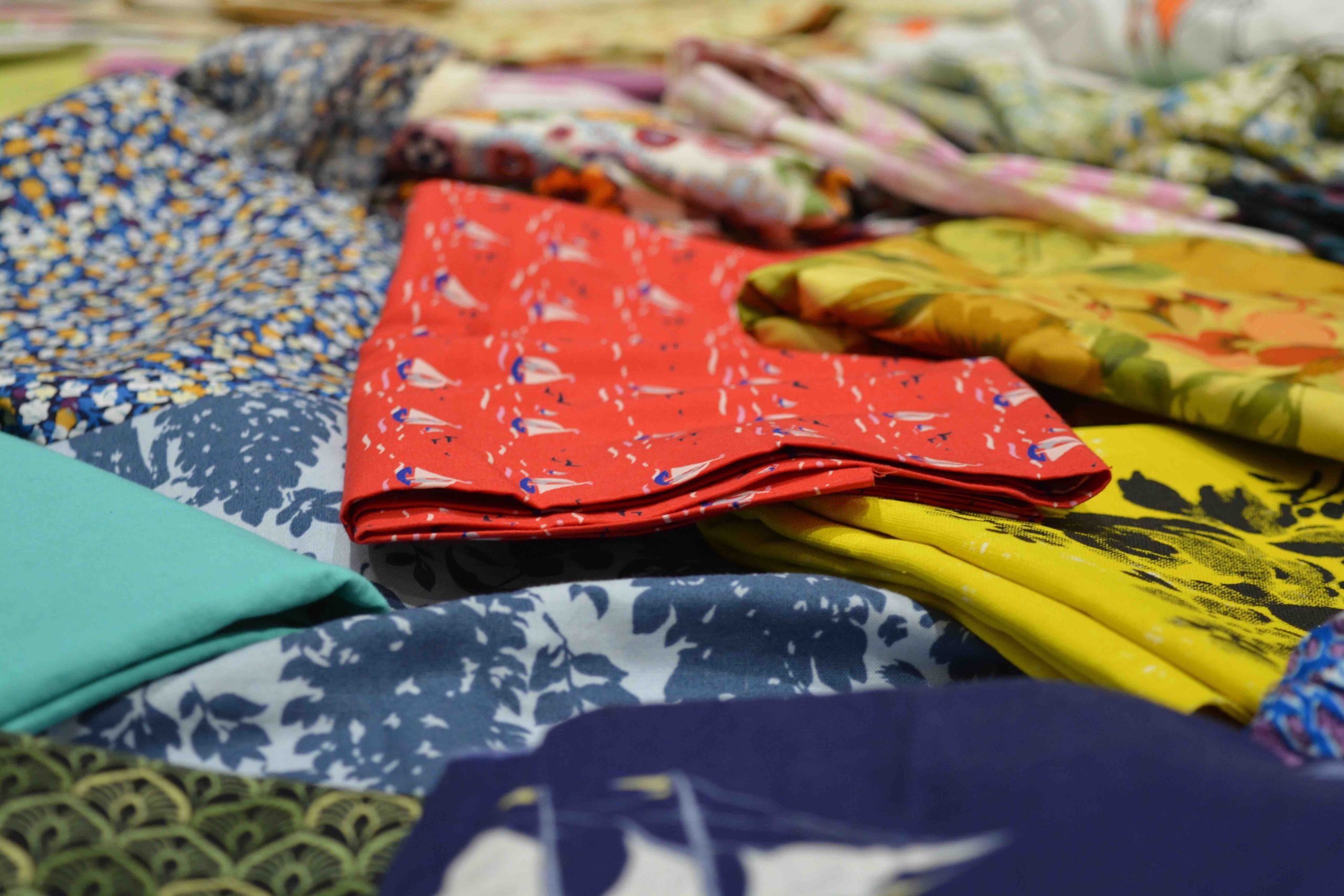
Lighter-weight woven and drapey
Silk – Silk is a natural fibre made from silkworm cocoons and has a shimmering appearance. It is smooth and soft to the touch. It is often the most luxurious and expensive fabric available.
Garments: lingerie, nightwear, blouses, dresses. Made from: Animal fibres. Sewing experience: Intermediate.
Crepe – Crepe can be made from silk, wool or synthetic fibres. It has a more structured crisp look and is popular in dressmaking because of it’s excellent drape.
Garments: dresses, skirts, tops. Made from: Manmade (synthetic and artifical fibres) or Animal fibres. Sewing experience: Advanced beginner.
Cotton lawn – lawns are lightweight and breathable and feel smooth to the touch made from 100% cotton plant. It has a soft drape and slightly translucent in appearance.
Garments: dresses, skirts, tops, shorts and can be used for linings. Made from: Plant fibres. Sewing experience: Beginner.
Cotton voile – voiles are similar to lawns in that they are also lightweight and breathable and feel soft against the skin. They are also made from 100% cotton but linen and polyester blends are also available. It is more sheer in appearance.
Garments: linings and homewares. Made from: Plant fibres. Sewing experience: Advanced beginner.
Georgette – Also known as crepe Georgette and named after French dressmaker Georgette de la Plante, it is sheer and lightweight with a dully grainy look made from silk. It has a great drape for dressmaking.
Garments: tops. Made from: Animal fibres. Sewing experience: Advanced beginner.
Chiffon – Chiffon is one of the most lightweight fabrics and tricky to sew for a beginner. It can be made from cotton, silk or manmade fibres. It appears as a fine mesh with a sheer appearance.
Garments: tops. Made from: Plant fibres, Animal fibres or Manmade (synthetic and artifical fibres). Sewing experience: Intermediate.
Rayon – Rayon (also known as Viscose) is a made from a manmade plant fibre but has the feel of a natural fibre such as silk or cotton.
Garments: tops. Made from: Manmade Plant fibres. Sewing experience: Advanced Beginner.
Satin – Satin fabrics have a shiny right side and dull wrong side. It can be made from silk, nylon or polyester. It has a good drape and structure but not sheer.
Garments: tops, skirts, dresses, lingerie, nightwear, homewares, upholestry. Made from: Plant fibres. Sewing experience: Advanced Beginner.
Lace – Lace is an open delicate fabric made from cotton, linen or silk fibres. It can also be manufactured from synthetic fibres. It is a beautiful fabric and has been used for centuries.
Garments: tops, skirts, dresses, lingerie, bridal. Made from: Plant fibres or Animal fibres. Sewing experience: Advanced Beginner.
Lighter-weight woven and not very drapey
Taffeta – is structured, stiff and smooth and usually made from silk. The weave of the fabric gives it it’s name and it is this weave that gives the fabric it’s structure.
Garments: bridal and evening wear. Made from: woven silk. Sewing experience: Intermediate
Organza – Organza is usually made from synthetic fibres, although originally silk. It is sheer and light-weight but structured and crisp.
Garments: bridal and evening wear plus accessories. Made from: Manmade (synthetic and artifical fibres). Sewing experience: Advanced Beginner.
Heavier-weight woven and drapey
Linen – Linen fabric is made from flax plant fibres. It is durable, strong and does not stretch. Linens are cool to wear in hot weather, although easily crease but are also popular to make a number of accessories.
Garments: trousers, dresses, tops, skirts, accessories, homewares. Made from: Plant fibres. Sewing experience: Beginner.
Gabardine – Gabardine has a smooth wrong side and diagonal ribbed right side, as do other twill weave fabrics. It is hardwearing and usually made from wool but can also be made from cotton or polyester.
Garments: trousers, coats, uniforms, outerwear. Made from: Plant fibres. Sewing experience: Advanced Beginner.
Velvet – Velvet has a characteristic pile where the threads lie in a specific direction and this is known as the nap. This gives the fabric a distinct smooth feel is you stroke it in the direction of the nap (or not, against the nap). It can be made from natural or synthetic fibres.
Garments: trousers, coats, dresses.Made from: Plant fibres or Manmade (synthetic and artifical fibres). Sewing experience: Intermediate.
Flannel – is a thick but soft woven fabric either made from wool, cotton or synthetic fibres. The fibres are brushed to raise them and giving the soft properties of the surface.
Garments: coats, sleepwear, accessories. Made from: Animal fibres, Plant fibres or Manmade (synthetic and artifical fibres). Sewing experience: Beginner.
Also heavier-weight and drapey
Sequin – Sequin fabrics can make glamorous party garments and are made from disk shaped beads, laying flat and stitched onto fabric. They can be a bit tricky to sew, particularly at the seams and have a good drape.
Garments: dresses, skirt, tops, accessories. Made from: Manmade (synthetic and artifical fibres). Sewing experience: Intermediate.
Heavier-weight wovens and not very drapey
Chambray – Chambray fabric is made from cotton or synthetic fibres. It is most often made from blue (or another colour) and white fibres and woven in a checkered or striped pattern. It is structured and heavier weight without much drape.
Garments: tops, shirts, dresses. Made from: Plant fibres or Manmade (synthetic and artifical fibres). Sewing experience: Beginnger.
Sateen – Sateen fabrics are made using cotton or rayon fibres, rather than the silk fibres used to make satin. Sateen has the structure of a cotton with little drape but has a sheen and soft feel.
Garments: tops, shirts, dresses, trousers, homewares, accessories. Made from: Plant fibres or Manmade (synthetic and artifical fibres). Sewing experience: Beginner.
Jacquard – Jacquard type fabrics are woven with silks to produce decorative designs that have a luxurious feel. They are used for upholestry and formal clothing. The fabric is reversible and can be made using silk, wool, linen, cotton or synthetic fibres to form the raised weave design (Brocade/ Damask are the designs).
Garments: upholstery, evening wear, formal wear. Made from: Plant fibres, Animal fibres or Manmade (synthetic and artifical fibres). Sewing experience: Beginner.
Wool – This covers a wide range of textures from soft and warm for clothing (e.g. wool blend for suiting) to heavyweight and tough for outerwear. It can be used for a range of sewing projects and comes in a huge range of colours and weights.
Garments: dresses, pencil skirts, coats, accessories and homewares. Made from: Animal fibres. Sewing experience: Beginner.
Denim – Denim is a strong and durable fabric made from traditionally blue and white 100% cotton threads woven in a twill weave. Have a look at your jeans to see the diagonal twill of the threads. In recent years the fashion for skinny jeans means that other fabrics are now woven into denim such as Lycra for some stretch.
Garments: jackets, jeans, accessories. Made from: Plant fibres. Sewing experience: Advanced Beginner.
Also heavier-weight and not very drapey
Leather – Leather is made from treated animal skins and has waterproof (if treated), warm and long wearing properties. It requires a special needle to sew with. The leather fabric marks once the needle has stitched the surface so you need to be accurate when sewing. Suede is a type of leather with a nap, made from the underside of the animal skin, as apposed to Leather, which is the topside. It is less durable and marks easily.
Garments: bags, gloves, jackets, skirts, upholstery, homewares. Made from: Animal fibres. Sewing experience: Intermediate.
Felt – Felt can be made from wool making it hardwearing and warm against the elements for garments such as coats but is also made from synthetic fibres for craft projects. It does not fray so can be cut without needing to finish the elements. Felt is formed by pressing fibres together.
Garments: coats, craft projects. Made from: Animal fibres or Manmade (synthetic and artifical fibres)
Stretch fabrics
Knits – There are lots of different types of knit fabrics, so we’ve included the most common ones below. They can be made from wool, cotton or synthetic fibres.
Jersey knits– the most common type of knit. It’s soft and suitable for garments such as t-shirts. The right side of the jersey fabric is smooth (it is made from knit stitches) whereas the back is is less smooth (as it is made from purl stitches, just like a knitted scarf would be). It stretches across and up/down. Jersey fabrics can be plain or patterned.
Ribbed knits– as the name suggests it has obvious ‘ribs’ along the fabric and is quite stretchy. Again good to tops. Unlike the jersey knit, the appearance of the ribbed knit is created by alternating rows of knit and purl stitches, as it would do when knitting a scarf. The ribbing gives more stretch across than up/down.
Interlock knits– a bit thicker than the jersey, ribbed and spandex knits, this also makes the interlock knit more stable. It is easier for beginners to sew with and can be used to make tops, skirts and dresses. It is a variation on the ribbed knit and formed of two rows of stitches and appears like one row is behind the other but it isn’t a double-knit fabric. Both sides are smooth like jersey, it doesn’t stretch out of shape or curl at the edges.
Lycra and spandex knits– the spandex and Lycra in these knits makes them stretchy but hold their shape well so can be made to be more fitted. They are heavier in weight than the jersey knits. Also good for tops and summer dresses too and widely used for activewear.
Ponte de Roma knits– a thicker and more structured knit fabric which can be less stretchy but is still soft and easy to sew. It’s ideal for wrap dresses as it will stretch but gives a smooth silhouette. You can also use it to make jackets and skirts or a suit. A good option for the colder winter months. It is made from a combination of synthetic, rayon and Lycra threads and a double knit. It is usually one colour rather than patterned.
Fleece – Fleece fabric is a very insulating fabric with nap and it’s high performance makes it suitable for outdoor wear. It has a nap and made from synthetic fibres. It is commonly a knit but may also be woven.
Garments: coats, trousers, hats, outdoor wear. Made from: Manmade (synthetic and artifical fibres). Sewing experience: Advanced beginner.
Lycra/ Spandex – Lycra is a trade mark for a synthetic fibre with elastic properties and often used interchangeably with spandex or elastane. It is strong, durable and stretchy.
Garments: swimwear, sportswear and dance wear. Made from: Manmade (synthetic and artifical fibres). Sewing experience: Intermediate.

